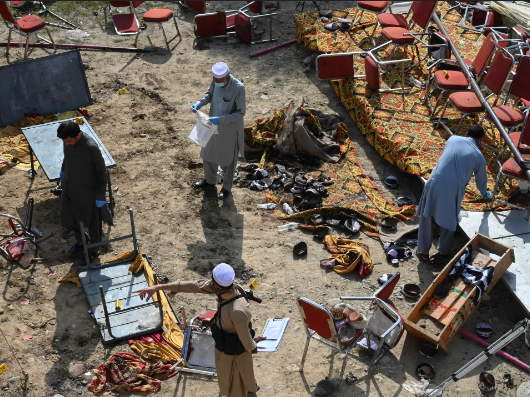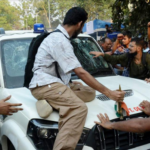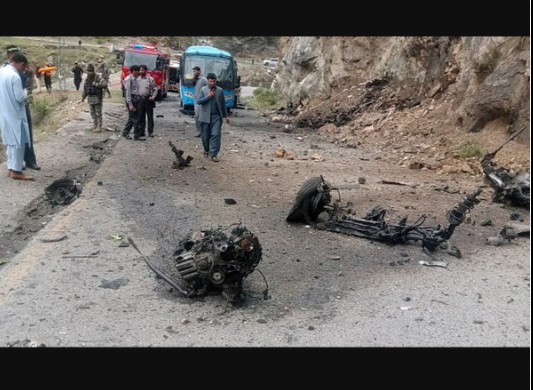In a shocking and brutal series of coordinated attacks in southwestern Pakistan, at least 39 people were killed, with 23 individuals fatally shot after being identified and taken from buses, vehicles, and trucks in the remote district of Musakhail. This tragic event has drawn national and international attention, highlighting the ongoing security challenges in the region. This article provides an in-depth analysis of the attacks, exploring the circumstances surrounding the incident, the possible motivations behind the violence, the broader context of instability in Balochistan, and the implications for Pakistan’s security landscape.
Introduction
The massacre in Musakhail, a district in Pakistan’s troubled Balochistan province, has once again brought to the forefront the complex and volatile security situation in the region. The coordinated nature of the attacks, the deliberate targeting of individuals based on identity, and the subsequent loss of life are indicative of the deep-seated issues that continue to plague southwestern Pakistan.
This incident not only underscores the ongoing insurgency in Balochistan but also raises critical questions about the effectiveness of the state’s security apparatus and its ability to protect civilians in one of the country’s most marginalized and conflict-ridden areas. As the country grapples with the aftermath of these attacks, it is crucial to understand the factors that led to this tragedy and the broader implications for peace and stability in the region.
The Musakhail Massacre: A Detailed Account
On a fateful day in Musakhail, a district known for its rugged terrain and tribal dynamics, a group of armed men carried out a series of attacks that left 39 people dead. The attackers, reportedly dressed in military-style uniforms, intercepted several vehicles, including buses, trucks, and other modes of transport, along a remote stretch of road.
The Sequence of Events
- Targeted Interceptions: The attackers set up roadblocks and ambush points at key locations, effectively trapping the vehicles traveling through the area. They stopped the vehicles, ordered the passengers to disembark, and began identifying individuals based on their ethnic, tribal, or sectarian affiliations.
- Execution of Victims: Once the attackers had identified their targets, they separated them from the rest of the passengers. The selected individuals were then lined up and shot at close range, leaving 23 people dead on the spot. The remaining victims were killed in subsequent attacks across different locations in the district, bringing the total death toll to at least 39.
- Escape and Aftermath: After carrying out the killings, the attackers fled the scene, disappearing into the rugged and remote landscape of Musakhail. The incident was reported hours later, as the region’s isolation and lack of communication infrastructure delayed the response of law enforcement agencies.
- Delayed Response: Given the remote location of the attacks and the challenging terrain, security forces and emergency services faced significant difficulties in reaching the crime scenes. By the time they arrived, the attackers had long since fled, leaving behind a scene of horror and devastation.
The Broader Context: Balochistan’s Volatile Security Landscape
Balochistan, Pakistan’s largest and least populated province, has long been a hotbed of insurgency, ethnic strife, and sectarian violence. The province’s strategic location, rich natural resources, and historical grievances have made it a focal point for various militant groups, insurgents, and criminal networks.
The Baloch Insurgency
- Historical Roots: The Baloch insurgency is rooted in the province’s long-standing grievances against the central government in Islamabad. These grievances include perceived economic marginalization, lack of political representation, and the exploitation of Balochistan’s natural resources without adequate compensation or benefit to the local population.
- Militant Groups: Several militant groups operate in Balochistan, each with its own agenda and modus operandi. Among the most prominent are the Baloch Liberation Army (BLA), the Baloch Republican Army (BRA), and the United Baloch Army (UBA). These groups have been involved in various acts of violence, including attacks on security forces, infrastructure sabotage, and targeted killings.
- Ethnic and Sectarian Tensions: In addition to the insurgency, Balochistan is also plagued by ethnic and sectarian tensions. The province’s population is ethnically diverse, with significant Baloch, Pashtun, and Hazara communities, among others. Sectarian violence, particularly against the Shia Hazara community, has been a recurring issue, with militant groups such as Lashkar-e-Jhangvi targeting Hazaras in brutal attacks.
- Cross-Border Dynamics: Balochistan’s proximity to Afghanistan and Iran adds another layer of complexity to the security situation. The porous borders allow for the movement of militants, arms, and narcotics, further destabilizing the region. Additionally, Baloch insurgent groups have been accused of receiving support from external actors, complicating efforts to achieve a peaceful resolution to the conflict.
Possible Motivations Behind the Musakhail Attacks
While no group has officially claimed responsibility for the Musakhail massacre at the time of writing, several theories have emerged regarding the possible motivations behind the attacks.
Ethnic or Sectarian Targeting
Given the pattern of the attacks, where individuals were identified and selected based on specific criteria, it is likely that the massacre was motivated by ethnic or sectarian animosities. In the past, militant groups in Balochistan have carried out similar attacks against specific communities, particularly targeting non-Baloch individuals or those belonging to rival ethnic or sectarian groups.
- Ethnic Cleansing: One possible motive is ethnic cleansing, where the attackers sought to eliminate members of a particular ethnic group from the area. Such tactics have been employed in the past by militant groups aiming to assert control over a region by driving out or killing those who do not belong to their ethnic or tribal group.
- Sectarian Violence: Another possible motive is sectarian violence. Balochistan has witnessed numerous sectarian attacks, particularly against the Shia Hazara community. If the victims in Musakhail were identified based on their sectarian affiliation, it could indicate the involvement of sectarian militant groups.
Coordinated Attacks Retaliation or Reprisal
Another possible motive behind the attacks could be retaliation or reprisal. Balochistan’s complex tribal dynamics often lead to cycles of violence, where an attack by one group is followed by a retaliatory strike by another.
- Tribal Feuds: Tribal feuds are a common occurrence in Balochistan, where disputes over land, resources, or honor can escalate into deadly violence. The Musakhail massacre could be the result of such a feud, with one tribe or group seeking revenge for a previous attack or perceived slight.
- Insurgent Retaliation: The massacre could also be an act of retaliation by insurgent groups against individuals perceived to be collaborating with the state or rival factions. In the past, Baloch insurgents have targeted civilians accused of aiding the government or providing intelligence to security forces.
Coordinated Attacks Political or Economic Motives
In addition to ethnic, sectarian, or retaliatory motives, the Musakhail attacks could also have been driven by political or economic factors.
- Political Intimidation: The attackers may have been seeking to intimidate a particular community or group to achieve political objectives. In a region where local politics is deeply intertwined with tribal and ethnic identities, such attacks can serve to undermine rivals or consolidate power.
- Resource Control: The massacre could also be linked to control over local resources, such as land, minerals, or smuggling routes. In Balochistan, competition for resources often leads to violent confrontations, with armed groups seeking to assert control through force.
The Response of the Pakistani Government and Security Forces
The Musakhail massacre has prompted a strong response from the Pakistani government and security forces, who have vowed to bring the perpetrators to justice and restore order in the region. However, the incident has also exposed the limitations and challenges faced by the state in dealing with the complex security situation in Balochistan.
Immediate Response and Security Operations
- Deployment of Forces: Following the attacks, the Pakistani government deployed additional security forces to Musakhail and surrounding areas to conduct search and sweep operations. The aim of these operations is to apprehend the attackers and prevent further violence.
- Intelligence Gathering: The government has also intensified intelligence-gathering efforts to identify the masterminds behind the massacre. This includes tracking communication networks, monitoring movements in the region, and interrogating suspects.
- Community Engagement: Coordinated Attacks prevent further escalation, the government has engaged with local tribal leaders and community representatives to maintain peace and order. These efforts are aimed at building trust and preventing reprisals that could lead to further violence.

Challenges and Criticisms
Coordinated Attacks Despite the government’s efforts, there are significant challenges to achieving lasting peace and stability in Balochistan.
- Geographical and Logistical Challenges: Balochistan’s vast and rugged terrain makes it difficult for security forces to effectively monitor and control the region. The lack of infrastructure, including roads and communication networks, further complicates security operations.
- Inadequate Resources: The security forces in Balochistan are often stretched thin, lacking the necessary resources and manpower to effectively counter the multiple threats in the region. This has led to criticisms of the state’s ability to protect civilians and maintain order.
- Human Rights Concerns: Coordinated Attacks response to insurgency and militancy in Balochistan has often been criticized for heavy-handed tactics, including alleged human rights abuses. This has fueled resentment among the local population and hindered efforts Implications for Pakistan’s Security Landscape to build trust between the state and the people.
The Musakhail massacre has significant implications for Pakistan’s security landscape, particularly in the context of the broader challenges facing the country. 
Escalation of Violence in Balochistan
Coordinated Attacks could lead to an escalation of violence in Balochistan, as retaliatory attacks and reprisals become more likely. This could further destabilize the region and complicate efforts to achieve peace and development.
Coordinated Attacks Impact on National Security
Balochistan’s security situation has a direct impact on Pakistan’s national security. The province’s strategic location, bordering Afghanistan and Iran, makes it a critical area for regional stability. Continued violence and instability in Balochistan could have broader implications for Pakistan’s security, including the potential for cross-border militancy and the destabilization of neighboring regions.
Humanitarian Concerns
The massacre also raises serious humanitarian concerns. The deliberate targeting of civilians and the loss of innocent lives highlight the need for greater protection of vulnerable communities in conflict zones. The incident underscores the importance of addressing the root causes of violence and ensuring the safety and security of all citizens.
Coordinated Attacks Conclusion
The coordinated attacks in Musakhail, resulting in the deaths of at least 39 people, are a grim reminder of the ongoing challenges facing Balochistan and Pakistan as a whole. The incident underscores the complex and multifaceted nature of the security threats in the region, where ethnic, sectarian, political, and economic factors intersect to create a volatile environment.
As Pakistan grapples with the aftermath of this tragedy, it is imperative that the government and security forces take a comprehensive approach to address the root causes of violence in Balochistan. This includes not only enhancing security measures but also addressing the underlying grievances and socio-economic challenges that fuel insurgency and militancy.
The Musakhail massacre should serve as a wake-up call for the need to prioritize peace, development, and human rights in Balochistan. Only through a holistic and inclusive approach can Pakistan hope to achieve lasting peace and stability in this troubled region. ALSO READ:- West Bengal’s Civic Police Volunteers: An Examination of Their Role, Accountability, and Controversies 2024





